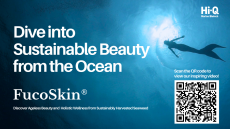Is men’s grooming still a lucrative market?

Product launches for men are becoming increasingly more sophisticated. For example, the French men’s grooming brand Horace has gained a cult following and recently opened a new bricks and mortar store in London’s Covent Garden – its first expansion outside of France.
Interestingly, the brand takes more of a ‘clean beauty’ approach and its products are more refined than men’s grooming brands of yesteryear.
Businesses are also innovating in new types of men’s products. For example, in the US market Procter & Gamble has just launched a full body deodorant: Old Spice Total Body Deodorant.
“While body odour is normal, it’s a concern for so many who aren’t quite sure how to address it beyond their armpits,” shared Dr Maiysha Jones, Principal Scientist, North America Personal Care at Procter & Gamble. “In addition to the armpits, body odour originates from odour-causing bacteria at skin folds like the groin, abdominal skin folds, and between your toes. Old Spice Total Body Deodorant has been formulated with a blend of minerals and skin-friendly ingredients that fight odour-causing bacteria and it’s gentle enough to use all over,” explained Dr Jones.
In some Asian countries, men’s grooming has been nearly as lucrative as women’s over the past decade. For example, according to Statista, in the fiscal year ended 31st March 2023, Japanese company Mandom Corporation generated net sales of around 38bn Japanese yen within the male grooming segment, with men's cosmetic brand Gatsby accounting for the largest share of this.
However, it appears that skin care, grooming, make-up products and cosmetic surgery for men are starting to break through any stigma that was previously held in Europe and North America.
So why are men suddenly taking up even more time in the bathroom? Whether it be for aesthetic reasons or protecting skin against harsh natural elements, men’s skin care could be now be considered as mandatory as cleaning your teeth.
Looksmaxxing and the rise of blepharoplasty
For younger men, there is also the popularity of the platform TikTok and the trend of Looksmaxxing that has been steadily building a following among both women and men over the past year or so.
Consultant oculoplastic and ophthalmic surgeon Dr Elizabeth Hawkes noted that in 2023, there was a huge rise in blepharoplasty (eye) surgery among men in the UK.
Figures from ISAPS, a professional body for aesthetic plastic surgeons, showed that this is now the second most popular surgical procedure for men.
Dr Hawkes said she also saw an increase in her own clinic last year for men for both upper and lower eyelid blepharoplasty surgery and noted that it wasn’t necessarily younger men asking for this procedure. “The average age based on my patients for upper eyelid blepharoplasty is 45 while it is 55 for lower eyelid blepharoplasty," said Dr Hawkes.
She believed that this had been sparked by the wellness movement “because how we look is associated with wellness,” she said. “A lot of patients may feel they are extremely successful in life and feel very healthy but when they look in the mirror, it's the eyes that make them look more tired. That’s why a lot of patients, including men, want to seek rejuvenation.”
Dr Hawkes also noted that with more Zoom meetings, men are looking at themselves more frequently than ever and “the more we look at ourselves, the more we start to see things,” she noted.
More men wearing make-up
Jake Xu, co-founder of Shakeup Cosmetics, is at the forefront of the men's cosmetics trend that’s seeing more men awakened to the necessity of skin care products.
A prominent industry disrupter, Shakeup launched into the UK’s leading health and beauty retailer, Boots last year, among other major outlets across the globe.
“In recent years, we have seen men being more open about their skincare routine or their skin issues. I think this was partially due to the Covid-19 pandemic,” he said.
“When we were on Zoom regularly, it forced us to look at ourselves more often than before. This highlighted insecurities. We all have them, and they can have a major impact on our confidence,” Xu shared.
“Our skin starts to age from the age of 25, and when it comes to managing ageing skin, it’s always easier to prevent or slow down the process, than to reverse or repair it,” he pointed out.
Xu revealed that his core demographic in the UK is men over the age of 35. However younger generations of men are trailblazing into the sphere and setting the bar high, not only aesthetically but experience wise.
With a fearless, fresh perspective, younger men are more willing to explore skincare options, discovering products that will not only enhance their appearance but protect their skin against everything from ageing to cancer. This is evident across many platforms, including TikTok, where content is awash with Gen Z men who have uploaded make-up tutorials.
“Younger generations are definitely pushing the boundaries and making people realise that it’s OK for guys to want to look after their skin,” Xu concurs.
“They are more open and aware. They are also more liberal and without much of the stigma or emotional baggage.
Meanwhile, over in the US market, men’s products and tools brand Manscaped appears to be unstoppable and has just launched into Walmart.
Make-up, at its inception, was actually designed for both genders. The earliest records of men wearing make-up date back to ancient Egypt, 6,000 years ago. From as early as 4000 BCE, pharaohs would apply heavy eyeliner, eyeshadow, lipstick, nail polish and face powder.
Although worn as a sign of wealth, it was also often part of a larger ritual believed to ward off bad spirits, appeal to the gods and make them appear more powerful in battle.
Still spending, despite price hikes
While statistically, today’s man may still feel discomfort at the thought of approaching a cosmetics counter, sales continue to soar, the issue being overcome by the anonymity of online purchasing.
The increased cost of living hasn’t seen a decline in what could be considered a vanity purchase either.
According to findings by Global Data in its 2023 Q4 Global Consumer Survey, nearly a third of European men continue to spend the same amount on skin care in spite of price hikes in every sphere of life.
A further 24% were revealed to be spending more and were prepared to absorb any rising costs for products they now rely on.
But which products are these consumers clamouring for?
In an industry fuelled by innovation and technology, shiny new options are constantly on the radar. How does a man embarking on a regime cut out unnecessary noise? The answer could be more straightforward than we think.
“We all have different skin that is unique to ourselves,” says Jake Xu. “We have a unique relationship with our skin, too. I don’t think you can have a box-standard healthy skin regime that works for everyone. However, the basic building blocks of a healthy skincare routine consists of five steps: cleanse, tone, treat, moisturise and protect.”




























